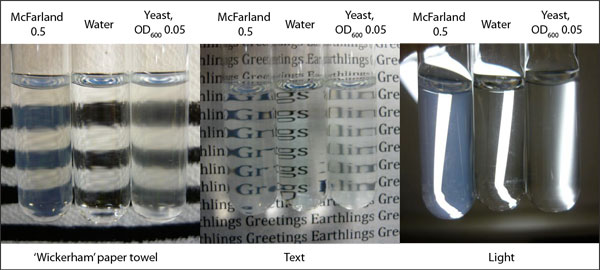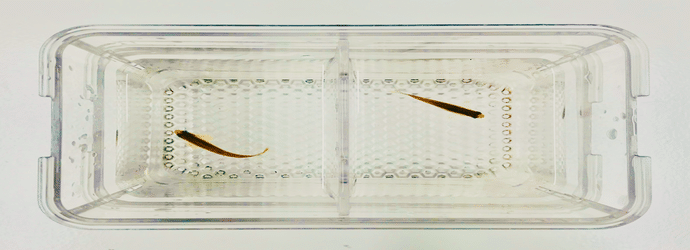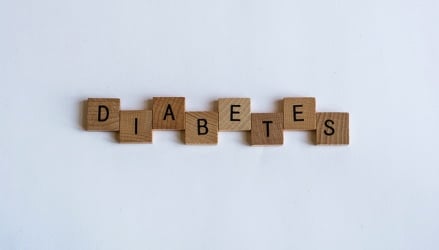Back in August I shared my training regimen for guesstimating the OD600 readings of microbial cultures with superhuman accuracy. Although my method is effective, I will admit that it has two shortcomings: you need to make a separate standard curve for each container type, and guesstimation is not an officially sanctioned scientific method. But now, thanks to a helpful reader’s comment, I can suggest an alternative that overcomes those shortcomings and still bypasses the need for a spec.
The method makes use of McFarland turbidity standards. These are solutions of a known turbidity that are used to standardize culture density in clinical antibiotic sensitivity testing. The tester compares bacterial cultures to McFarland standards by holding them next to each other in front of a ‘Wickerham card’ (which is just a white card with black stripes printed on it). Cultures of a similar turbidity to the standard will blur the black lines to about the same extent.
These standards can easily be adapted for use in estimating OD600. Simply keep a few McFarland standards around that correspond to the range of ODs that will be most useful to you. As in my original method, to make an accurate comparison, the culture and the standards should be in the same type of container, but you can make a big batch of standards to decant into different containers as necessary.
How to Make McFarland Standards
McFarland standards are suspensions of a barium sulfate precipitate, which is made by mixing various amounts of barium chloride with sulfuric acid.
|
McFarland Standard |
Amount of 1% BaCl (ml) |
Amount of 1% H2SO4 (ml) |
|
0.5 |
0.05 |
9.95 |
|
1.0 |
0.1 |
9.90 |
|
2.0 |
0.2 |
9.80 |
|
3.0 |
0.3 |
9.70 |
If the containers are sealed to prevent evaporation, they can be used for about six months. You can also buy ready-made McFarland standards that are made from latex beads and can be stored indefinitely.

Tips for Using McFarland Standards
- You can make the ‘Wickerham card’ in any way you like – with a pattern, or text, for instance. I find I can make the most sensitive distinctions by holding my sample and standard up to the light.
- Remember that the number of the McFarland standard unit does not correspond to the OD600 value. A McFarland standard of 0.5 should have an OD600 between about 0.08 and 0.1 but you will have to determine this relationship for your particular spectrophotometer.
- You will need to do a few tests with a spectrophotometer to get used to comparing the standards to real cultures. For instance, the commercially available latex beads give a slightly blue cast to the solution that can be distracting. I’ve also found that yeast cultures have a slightly different appearance to the beads at the same turbidity, perhaps because they have different particle sizes.
The beauty of all this is that it takes no time at all to monitor cell density in this way, yet the procedure can be accurately described and replicated in any laboratory.





